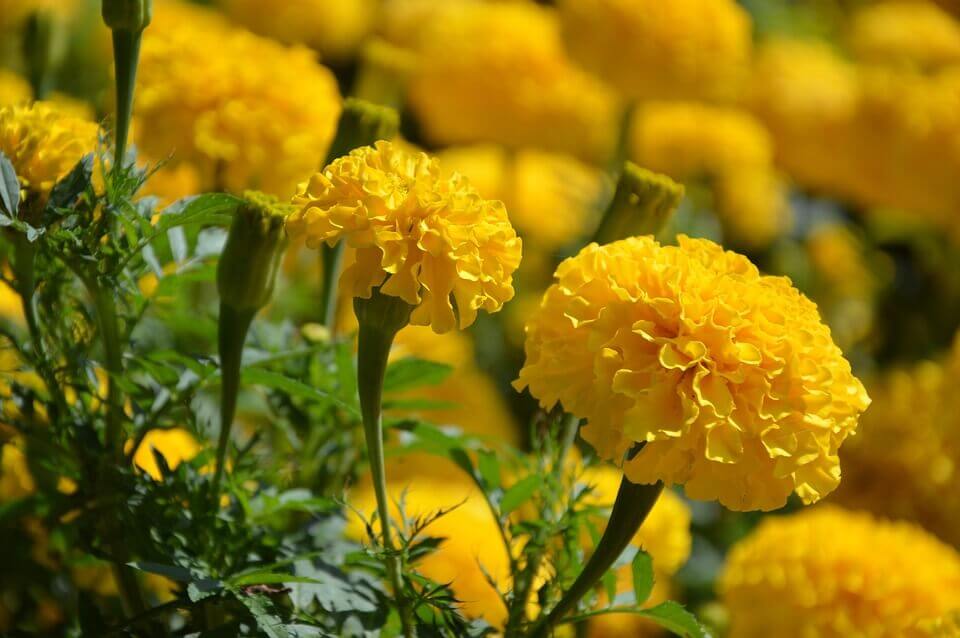Marigolds are beautiful blossoms that have daisy-like flowerheads, produced in clusters or as a single flower. If you want to learn how to grow marigolds, you first need to know about the wide varieties of the flower. There are more than 50 species of marigolds that you see in gardens and can grow several in yours as well.
Let’s learn about the right ways of growing marigolds and get the perfect idea of choosing the variety, planting, harvesting, and taking care of the flowering plant.

Growing Marigolds
Marigolds are a flower species that are largely stereotyped and found commonly in home gardens and backyards. However, not many know they come in surprisingly broad varieties, and relaxing aroma.
Check out the types of marigolds you can choose from:
Tagetes erecta: Also called American marigolds, African marigolds, or Mexican marigolds, this is the most upright and tallest species of marigolds. It can grow up to a height of 3-4ft and produces full and large fowers.
The species is native to Central America and Mexico. They can thrive in drought-like conditions as well.
Tagetes patula: Also called French Marigolds, these tend to be bushier, smaller, and more compact as compared to T. Electra. They are not tall but spread wider as they grow.
T. Patula reaches the height of 6 inches to 2 feet and produces demure flowers. The species grows well in rainier conditions.
Tagetes tenuifolia: Also called Signet marigolds, these are petite marigolds that thrive in hot and dry weather conditions. They hardly reach to the height of one foot but serve as a great edging plant.
Calendula officinalis: Also called English marigolds or Pot marigolds, this species is a native of Southern Europe. However, it is not considered as a true marigold type. You can choose this as an attractive flower plant whatsoever.
The bright flowers it produces are edible with a peppery, tangy taste. Natives of Southern Europe mostly grow the variety alongside herbs.
Choosing the right planting site
- Marigolds grow best in full sun and can withstand scorching summers. Signet and African marigolds are tolerant of drought or dry conditions, while French marigolds and rain tolerant. They grow well in wet conditions.
- So, you need to choose the planting site based on the type of marigolds you want to grow.
- The plant can grow well in almost all kinds of soil but does best in well-drained and moderately fertile soil.
- You should prepare the soil by digging the area 6 inches deep and loosen it. Remove all the stones around.
- When planted in cool, shady, or moist areas, marigolds won’t flower well and end up with powdery mildew.
Planting marigolds
- If you choose young signet and French marigolds, you can plant those in spring through mid-summer. In the case of African marigolds, you must plant them right in the spring, after the frost season passes.
- African marigolds take time to mature and bear flowers.
- You can easily plant French marigolds using seeds, but the African varieties take very long from seed. So, it’s recommended to buy a young plant of the African marigolds.
- As soon as you notice the soil in your garden turns warm in the spring season, sow the marigold seeds.
- Moisten and sow the seeds – 1 inch apart and 1 inch deep.
- Thin the seedlings while it’s still small.
- You must space signet and French types 8-10 inches apart, whereas the larger African varieties should be 10-12 inches apart to the least.
- They germinate very well outdoors, so you need not try growing marigolds indoors.
- If you are planting marigold transplants, make sure to water the plants thoroughly after moving it to the garden.
- In warm weather, marigolds sprout in a week and start producing blooms within two months or 8 weeks.
- When growing marigolds in containers, do it in soil-based potting mix. You can choose one of the two options – mix water and diluted liquid fertilizer to water it or mix in slow-acting granular fertilizer.
- Make space between the marigolds grown in containers or they will look crowded.
Note: If the soil seems nutrient-starved, you can add some granular fertilizer in the planting site (5-10-5 works well).
Taking care of marigolds
- As soon as you see the marigolds getting well-established, pinch off the tops to promote them turn bushier as they grow.
- It will prevent them from turning leggy and encourage proper blooming.
- While growing marigolds, you don’t need to do the deadheading, however, if you see the blossoms are dying, you should keep removing them to allow profuse blooming.
- Between waterings, make sure the soil dries out. You should water marigolds more during hot days.
- Water at the base of the plant, and not overhead.
- Avoid fertilizing marigolds during the growing stage. A diet high in nitrogen can stimulate lush foliage ruining the flowers.
- You can add a mulch between plants to avoid weeds.
- Keep the soil moist during growth.
Deadheading marigolds
By deadheading marigolds, you can boost the production of more flowers, and extend the flowering season.
Here’s how you can deadhead marigolds:
- As you notice a blossom turning bad/dying, pinch the stem back to the closest pair of leaves.
- This encourages the plant to bear more flowers, and faster.
Pests & Diseases affecting the growth of marigolds
While growing marigolds, you may not come across the problems of pests/diseases more often, but there are a few bugs that may infest your plants. Some of the common ones include spider mites and aphids.
Mostly, a spray of a combination of insecticidal soap and water works well to remove the pests. You should repeat the drill every alternate day for a couple of weeks.
Sometimes, your marigold plant may get affected by powdery mildew, a fungal disease due to wet conditions. To avoid the situation, don’t spray water on the leaves, plant it in fertile and well-drained soil, and keep away from weeds.

Marigolds – Your companion plants
Gardeners and farmers often promote growing marigolds as companion plants in the garden. The underground areas of French marigolds are known for repelling harmful microscopic worms like nematodes that attack the roots of your vegetables.
The crops most affected by worms like lesion nematodes and root-knot nematodes include cucumbers, tomatoes, snap beans, strawberries, squash, garlic, and onions.
If you want the benefits of marigolds as companion plants, you should not plant them very close to the vegetables. Plant a group of marigolds during spring in the region where you wish to plant a fall crop.
In mid-to-late summer season, you can remove marigolds and grow greens and vegetables for a fall harvest.
In a Nutshell
Marigolds are found in wide varieties, and you must choose one that suits your area and growing conditions best. Now that you have adequate information about growing marigolds, we hope you get to have a colorful garden and also protect your greens from microscopic worms.
You may also like to read
How to Plant and Grow Roses – A Complete Guide
Propagating Hibiscus: Grow the Beautiful Plant in Your Garden






